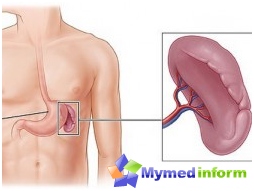In addition, splenomegaly can be caused by various diseases in which the increase in lymph nodes is observed. So, nodes may increase due to infectious inflammation, infiltration cancer cells, as well as due to increased blood cell destruction.
The increase in the spleen is primarily determined by tacking. Only this method can not be called accurate. Therefore, in addition to tackling in order to clarify the diagnosis, computed tomography and radionuckeled scanning are used.
Causes

The pronounced increase in the spleen may appear in chronic lympholoicosis, chronic myelolomicosis, non-kindly lymphoma, high-meal leukemia, true polycythemia and myelofibrosis with myeloid metaplacia. Such pathology is also observed in the late stage in the third part of people suffering cirrhosis. Signs of the cirrhosis is also jaundice, cluster fluid in the abdominal cavity, edema foot and the increase in the liver. In such patients, hepatic encephalopathy is formed, which manifests in the form of illegibility of speech and lowering the level of consciousness.
The reason for the appearance of stagnation of splenomegali can be thrombosis of splenic veins and individual violations of vessels. In addition, the spleen may increase with heavy forms of brucellosis. This is a rather rare disease. His first symptoms is headache, Weakness, lower back pain, heat, bad appetite and sweating. Later the spleen and liver increase.
Some infectious and inflammatory diseases can cause an increase in spleen. In particular, these are acute infections (for example, subacute infectious endocarditis) and amyloidosis. When the anomalous amyloid protein in the spleen accumulates, it may arise its pronounced increase. At the same time, the concomitant signs of the disease are the most different. Sometimes renal failure is diagnosed, which manifests itself in the form of a lack of urine. Can manifest heart failure, in the form of Tachycardia and Dysfots. In addition, the increase in the spleen may violate the gastrointestinal tract.
Provice the development of pathology can chronic infections, sarcoidosis and some connective tissue diseases. The increase in the spleen is also manifested in the second-third week of endocarditis. At the same time, it flows along with other symptoms of the disease.

Diagnosis of the disease initially collected information from the patient's words. It is necessary to find out what disease led to an increase in the spleen and what the patient's complaints. The doctor usually finds out how long these symptoms began to disturb the person and with which he binds their appearance. Doctor also need to know if the patient visited exotic countries before the start of the disease, were there any changes in general condition, did the patient smoke and is he abuses with alcohol.
In addition, the doctor is extremely important information about whether relatives have a patient for the patient of the gastrointestinal tract, blood, spleen and liver. Next, prostrate the spleen is carried out to determine its size, soreness and density. Then the patient is recommended to pass some laboratory research. In particular, clinical blood analysis, biochemistry, Coagulogram, general urine analysis, Coprogram, the analysis of the feces on the eggs worms, and also occurs sowing blood to identify the type of infection pathogen. In addition, the passage of ultrasound of the abdominal bodies, computed tomography, sternal puncture, autoimmune biochemical markers and a genetic study can be appointed.
Treatment

The treatment of splenomegaly, primarily aimed at therapy of the underlying disease. In some cases, the question of the need to remove increased spleen surgically. For example, surgical intervention is shown in the disease Gosh, Thalassemia and high-meal leukemia. When removal, the patient's susceptibility to pneumococcus, hemophilic chopstick and meningococcus increases. For this reason, such patients conduct the appropriate vaccination.
Prevention
Since the increase in the spleen is not an independent disease, then some specific prophylactic measures of this pathology do not exist. As prevention, measures are used that allow you to prevent the appearance of diseases causing splenomegaly. In particular, patients are recommended to abandon smoking, alcohol consumption. It is also necessary to conduct vaccination of patients in time, for example, if you plan to travel to exotic countries. To prevent the division of the spleen of the MirSestes, it recommends to engage in moderately physical activity. In addition, a couple of times in the year it is desirable to inspect the specialist doctors.









